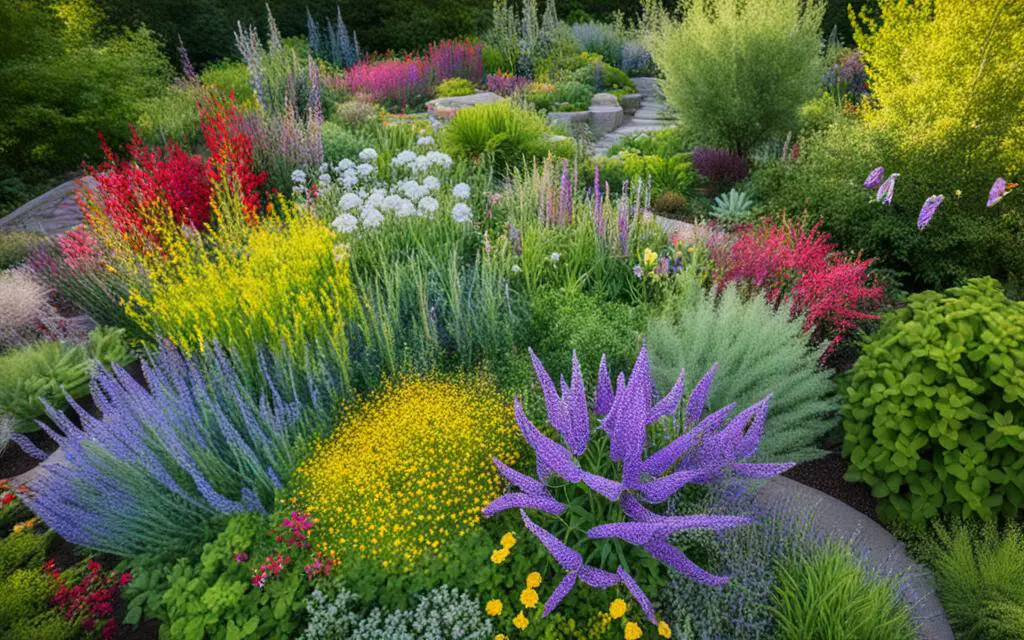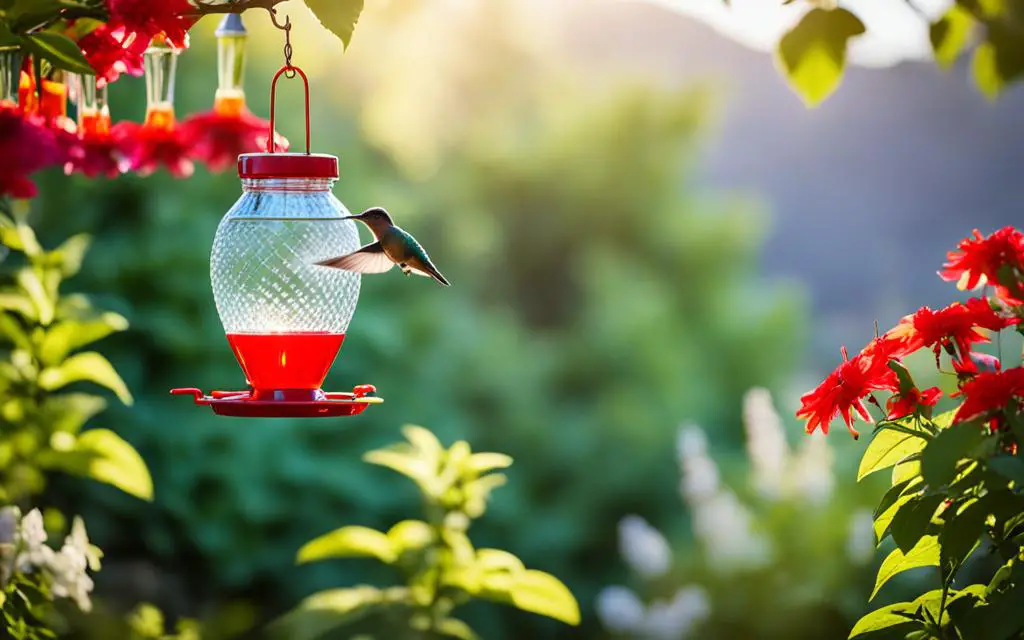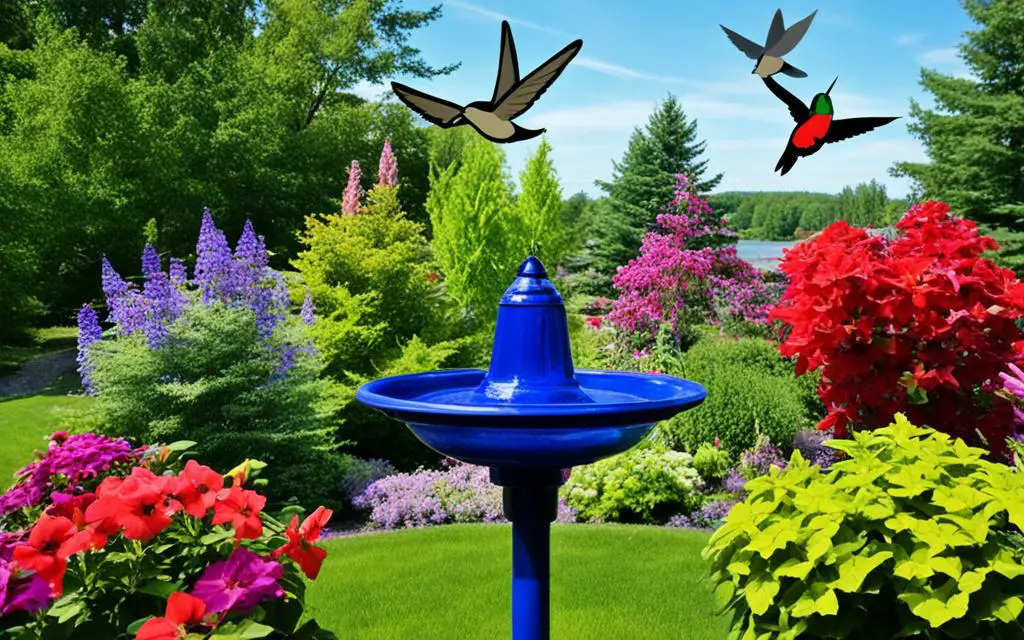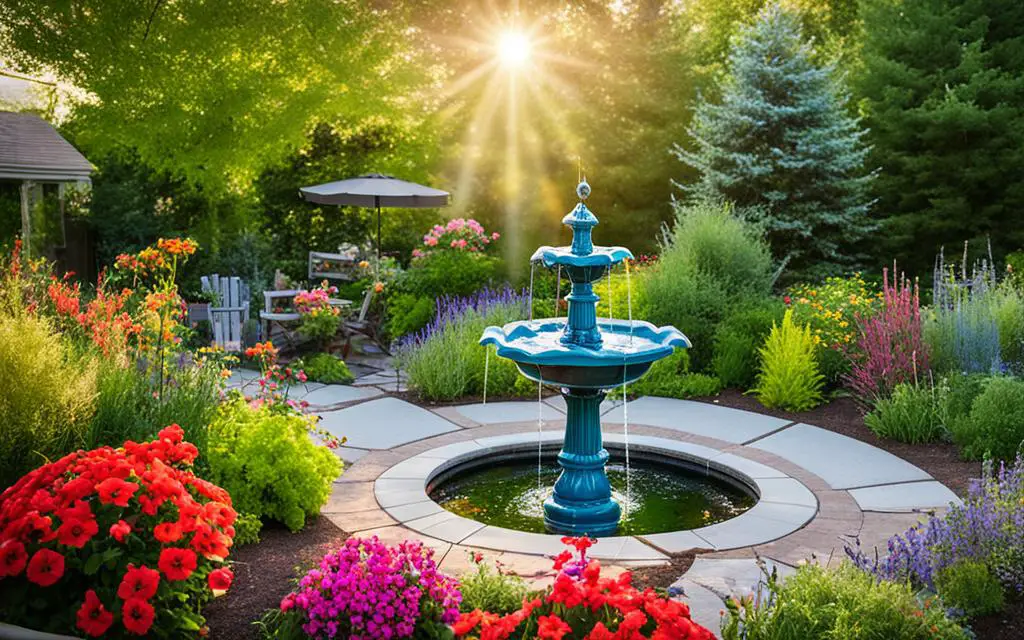Did you know hummingbirds are the smallest migratory birds? They can fly up to 3000 miles during their migration. This is just one amazing fact about these birds. By learning the secrets of attracting hummingbirds, you can watch them in your yard. To attract hummingbirds, make an environment that supports their lives. By creating a hummingbird-friendly yard, you give them a resting spot. And you offer them a place to refuel on their long journeys.
A sanctuary for hummingbirds is more than pretty; it supports their survival. Imagine your garden full of hummingbirds, with their colorful feathers and gentle buzzing. With the right steps, this can be your reality every day.
Key Takeaways
- Discover the key elements that make your yard irresistible to hummingbirds.
- Learn about native plants that provide nectar and attract these tiny fliers.
- Understand how simple additions can make your yard more attractive to hummingbirds.
- Gain insights on feeder types and why keeping them clean is crucial.
- Explore the importance of safe perching and nesting areas for a good habitat.
Understanding the Hummingbird’s World
Hummingbirds are amazing with their bright feathers and fast wing movements. They make our gardens lively and show they’re healthy. To welcome them, learn about their traits, myths, and why they eat the way they do.
Characteristics of Hummingbirds
These birds are small but have dazzling colors and move energetically. They can stay still in the air, zip to flowers, or fly backward. Knowing this helps with tips for hummingbird attraction.
Common Misunderstandings About Hummingbirds
There are many myths about hummingbirds. One is that they only like red flowers. That’s not true; they love all bright flowers. This matters for making your garden a place they’ll keep visiting.
The Importance of Their Feeding Habits
Hummingbirds need food often because of their fast metabolism. They eat nectar and insects. Placing feeders correctly helps them a lot, especially when migrating. Good hummingbird feeder tips are key.
| Aspect | Importance | Tips |
|---|---|---|
| Feeder Design | Prevents disease; ensures accessibility | Opt for an easy-to-clean feeder with perches |
| Feeder Solution | Mimics natural nectar; provides energy | Use a 4:1 water to sugar ratio, boiled and cooled |
| Feeder Maintenance | Maintains health of hummingbird populations | Clean regularly with hot water; avoid soap and chemicals |
If you are looking to purchase an awesome hummingbird feeder, I am recommending the feeder I use and love!
Learning about hummingbirds makes your garden welcoming for them. Use these tips, and your garden might become a favorite spot for these beautiful birds.
The Significance of Native Nectar Plants
To really attract more hummingbirds, think about adding native nectar plants to your garden. Plants like honeysuckle and trumpet creeper catch these birds’ eyes with their red blooms. They also give them the nutrients they need.
When looking for hummingbird plant suggestions, start with native ones. These plants are designed to help local wildlife. They ensure hummingbirds have enough nectar. In this win-win situation, hummingbirds get food, and plants are pollinated. This makes your yard a key spot for these birds. Let’s check out some key native plants that attract hummingbirds.
| Plant Name | Flower Color | Bloom Period | Benefits to Hummingbirds |
|---|---|---|---|
| Trumpet Creeper (Campsis radicans) | Orange-red | Summer to Fall | High nectar production |
| Red Cardinal Flower (Lobelia cardinalis) | Brilliant red | Late summer | Long bloom time attracting multiple visits |
| Coral Honeysuckle (Lonicera sempervirens) | Red to coral | Spring to Fall | Tubular flowers perfect for feeding |
| Bee Balm (Monarda didyma) | Bright red | Summer | Attracts both hummingbirds and insects |
Talking to a local native plant nursery is wise. It helps with region-specific hummingbird plant suggestions. It also helps protect local ecosystems. At the same time, you make your space welcoming to both humans and hummingbirds. By choosing these plants, you bring more hummingbirds and make your garden more beautiful and lively.

Designing a Hummingbird-Friendly Habitat
Creating a yard that hummingbirds love means blending features they enjoy. This not only helps their wellbeing but lets you watch their colorful dance all year.
Plant groupings for year-round bloom and natural water sources attract hummingbirds. Adding various perches and nests makes your yard a haven for them and a joy for you.
Plant Groupings for Year-Round Bloom
For a steady food supply, plant native flowers that bloom in different seasons. This way, there’s always something for the hummingbirds to feed on, no matter the time of year.
Keeping a Natural Water Source in Your Yard
Hummingbirds need reliable water sources. A birdbath with a gentle fountain feels like a natural stream to them. This makes your yard more inviting.
Providing Safe Perches and Nesting Spots
Nest spots and perches near foliage are crucial for safety. This gives hummingbirds a place to rest and watch their area safely.
| Season | Flowering Plants | Benefits |
|---|---|---|
| Spring | Columbine, Lupine | Early bloomers offering nectar |
| Summer | Bee Balm, Salvia | Bright, tubular flowers rich in nectar |
| Fall | Autumn Sage, Jewelweed | Late bloomers helping migration |
| Winter | Winter-blooming Manzanita | Provides nectar when resources are scarce |
Designing your yard with these features makes it hummingbird-friendly. Imagine your garden alive with vibrant colors and activity as hummingbirds visit.
Secrets to Attracting Hummingbirds to Your Yard
To attract hummingbirds, you need more than a feeder. Create a sanctuary that meets their needs. Use key tips for hummingbird feeders. Learn the best ways to set up and take care of your feeders. This will help you draw these birds to your yard.
Create a Feeder Sanctuary
Understanding hummingbirds’ territory is crucial for a welcoming space. Place multiple feeders around, out of sight from each other. This reduces their fights and lets them feed peacefully. In doing so, your garden becomes a safe place they love to visit.

Tips for Feeder Selection and Placement
Choosing and placing feeders is key to attract these birds. Pick saucer-shaped feeders with several ports. Select feeders that are easy to clean. Make sure the nectar is always fresh for your tiny visitors.
Place your feeders near natural shelters like bushes or trees to provide the hummingbirds with a sense of security, but also in locations with clear visibility to entice passing birds.
Maintaining a Clean and Safe Feeding Environment
Keeping your hummingbird feeders clean is essential. A clean feeder attracts more birds and keeps them healthy. Clean feeders with vinegar or bleach, and rinse well. Change the nectar often to stop it from spoiling, especially when it’s hot.
By following these hummingbird feeder tips, you can enjoy watching these beautiful birds. You’ll create a safe and welcoming space in your yard. Enjoy their vibrant presence and make your outdoor experience better.
The Importance of Feeder and Flower Placement
To master the secrets to attracting hummingbirds, you need more than just feeders or flowers. Attracting hummingbirds means understanding they look for visual signs. Place feeders where these birds like to go, and make sure they’re easy to see.
Colors are key in getting their attention. Red works best for feeders. It’s bright and draws in hummingbirds without harmful dyes.

How you set up your space matters a lot for attracting hummingbirds. Their amazing memory remembers where feeders are. So, keep your feeders in the same spot every year. This builds trust and makes them keep coming back.
Think of your garden as a special retreat. A place that’s safe and well-known for them. By carefully choosing where to put feeders and flowers, you unlock the secrets to attracting hummingbirds.
Perches, Insects, and Birdbaths: Beyond Nectar
Want to be great at bringing hummingbirds to your yard? Know that they look for more than nectar. They need a place that fits their food needs and lets them rest and play. We’ll share how to attract them with nature, not just feeders filled with nectar.
Incorporating Insect-Pollinated Flowers
Insects, not just nectar, give hummingbirds important proteins. Add flowers to your garden that insects like. This attracts the insects and the hummingbirds, meeting their needs.
Setting Up Misting Devices and Drip Baths
Water features also draw hummingbirds to your yard. A misting device or drip bath excites them. They love to splash and drink, and you’ll enjoy watching them.
Attracting Hummingbirds with Overripe Fruit
Don’t forget about overripe fruit. Put baskets in your garden for insects, which hummingbirds feed on. This attracts both insects and birds, helping your garden thrive.
| Attraction Method | Bird Benefit |
|---|---|
| Insect-Pollinated Flowers | Protein-rich diet from insects |
| Misting Devices / Drip Baths | Hydration and enjoyable bathing |
| Overripe Fruit Baskets | Provides a source of insects for feeding |
Conclusion
Creating a yard that welcomes hummingbirds is truly rewarding. It starts when you uncover the secrets to attracting hummingbirds to your yard. You’ll need to provide constant nectar sources. This includes well-chosen feeders and a variety of native plants.
Follow these hummingbird garden tips for success. Keep feeders clean and have many flowering plants that bloom at different times. This makes your garden a perfect spot for them. It turns into a safe place where hummingbirds can show their natural behaviors joyfully. Adding perches among the flowers gives them a place to rest and enjoy the garden you’ve carefully made.
Their magical presence in your garden is a sign of your hard work. Your garden is now a lively blend of colors and life, showing how humans and nature can work together. Keep being patient and dedicated. Then, your garden will always be loved by hummingbirds. This ensures these beautiful birds keep bringing joy to your home.
FAQ
What are some characteristics of hummingbirds?
Are there common misunderstandings about attracting hummingbirds?
Why are feeding habits important for attracting hummingbirds?
How do native nectar plants attract more hummingbirds?
What should I include in designing a hummingbird-friendly habitat?
How do I create a feeder sanctuary in my yard?
Could you provide tips for feeder placement?
Why is it important to maintain a clean and safe feeding environment?
What is the role of perches, insects, and birdbaths in attracting hummingbirds?
How can overripe fruit attract hummingbirds to my yard?

My name is Shane Warren, the author behind Your Bird Buddy – your ultimate guide to the wonderful world of birds! Unleash your inner avian explorer as we delve into a vibrant library of knowledge dedicated to all things feathered. From learning about diverse bird species from across the globe to understanding their captivating habitats and behaviors, I’m here to fuel your passion for these magnificent creatures. Not only that, but I also provide valuable insights on being a responsible and informed pet bird owner. Join our vibrant community and let’s celebrate the feathered wonders of the world together – one chirp at a time. And be sure to join our Your Bird Buddy Community over on Facebook!


Comments are closed